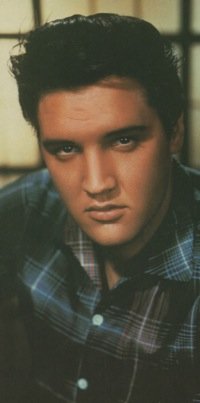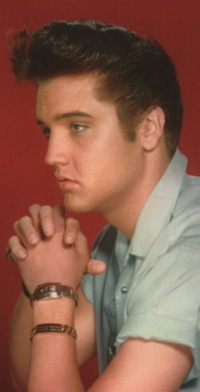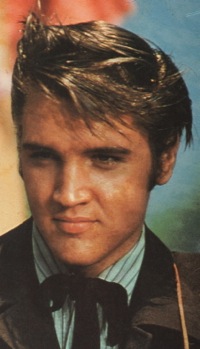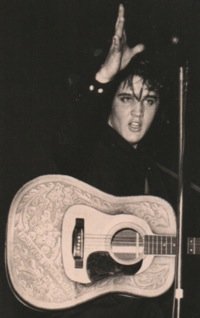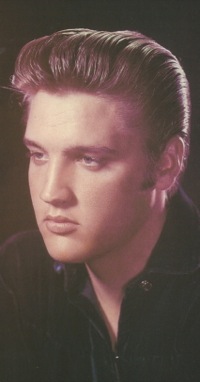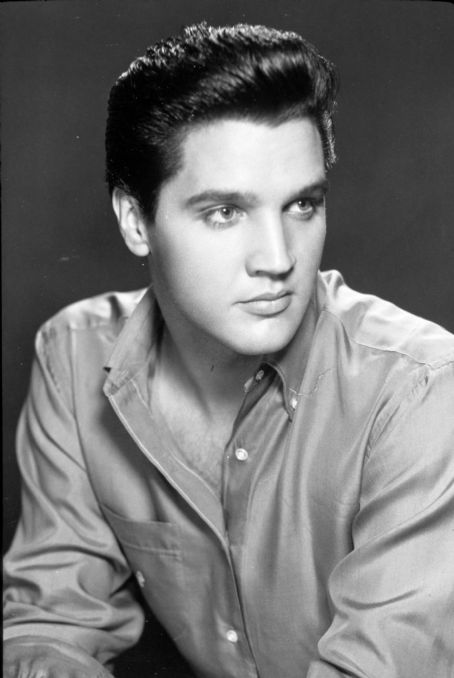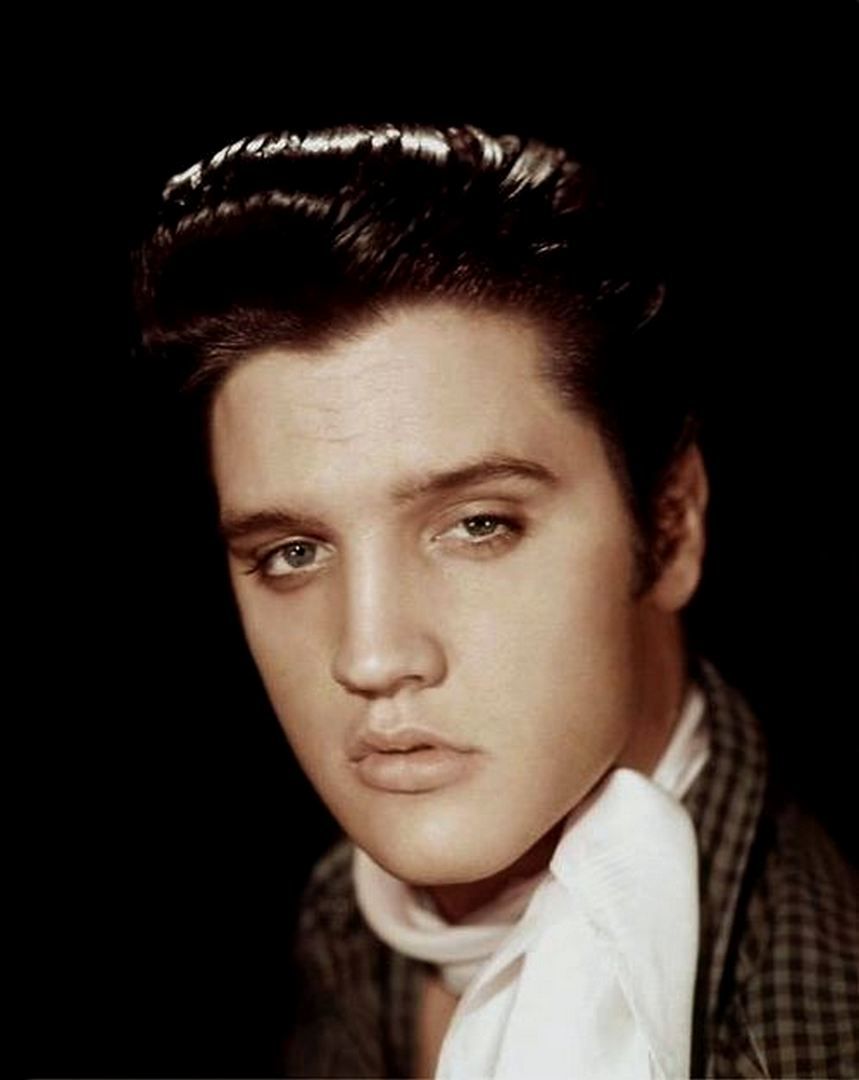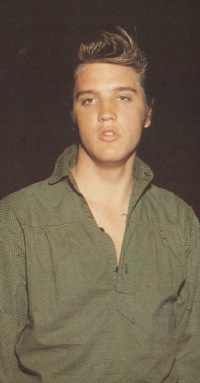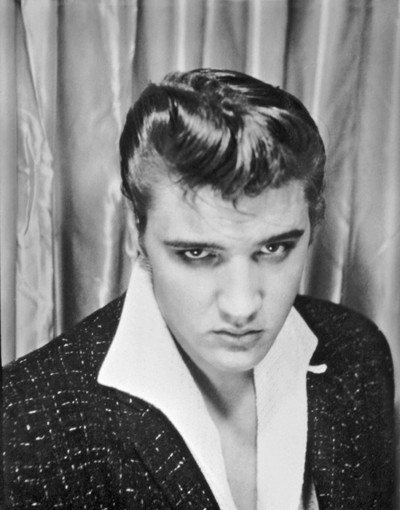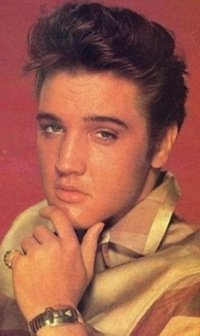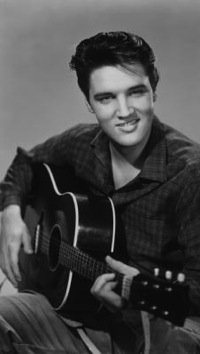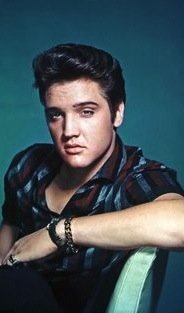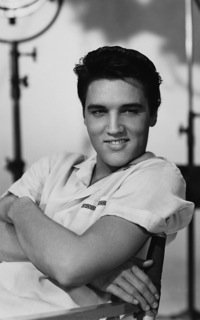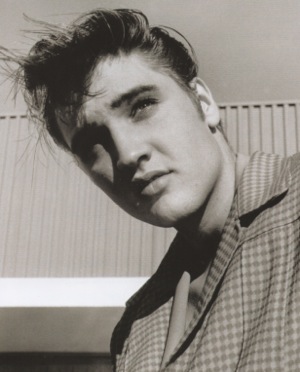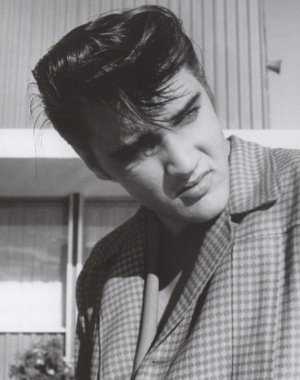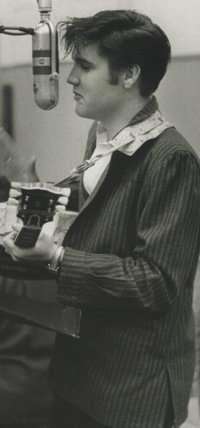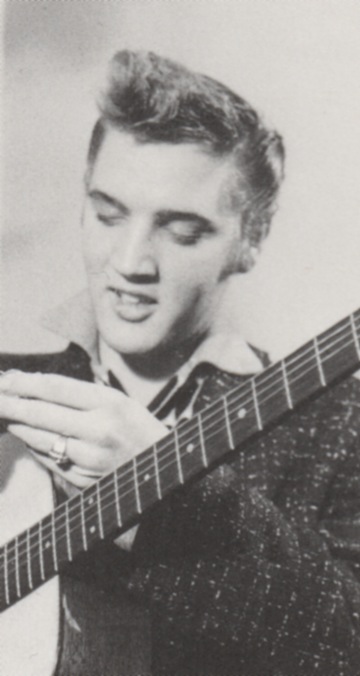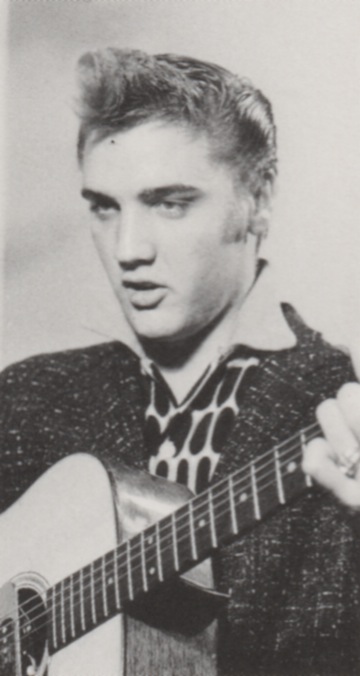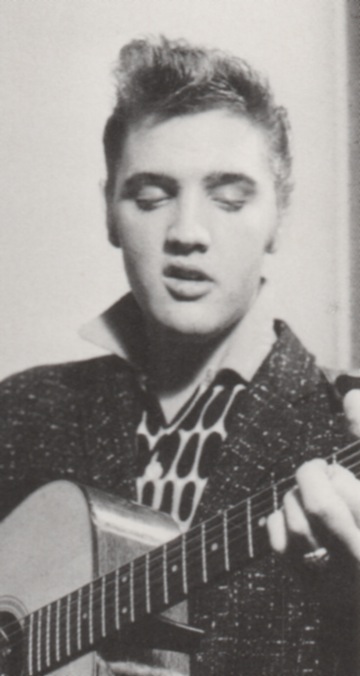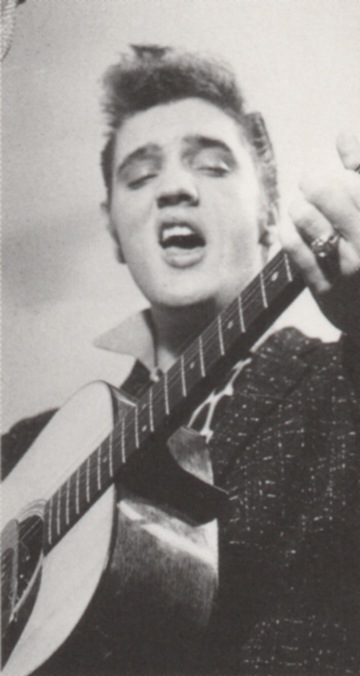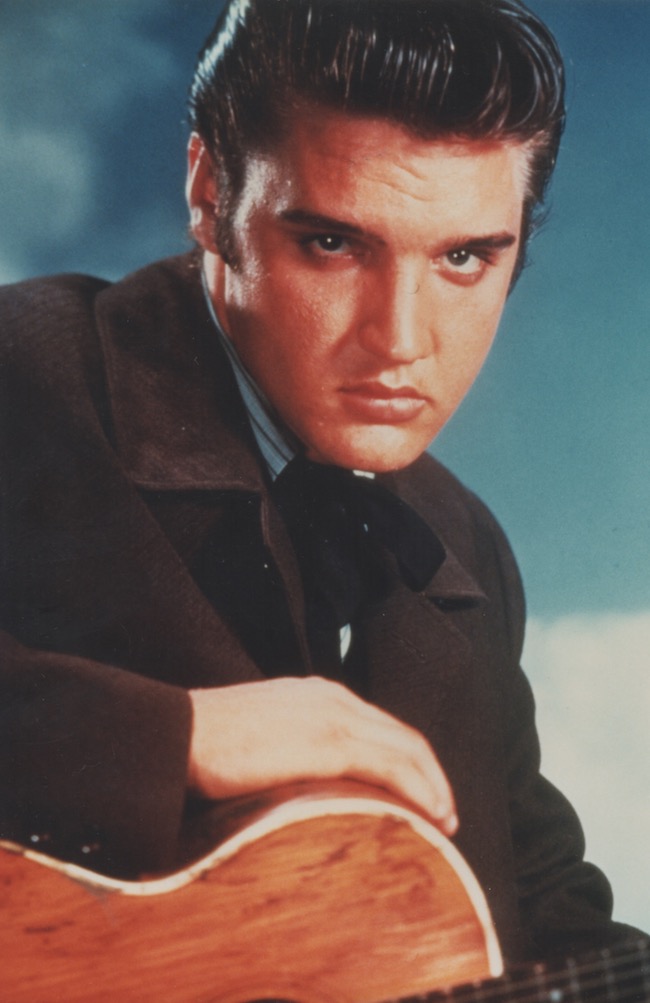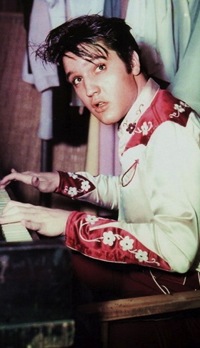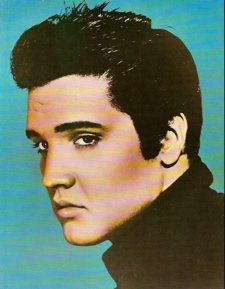Elvis History Blog
Elvis Presley's 1950s Sideburns
Caused Angst and Adoration
“I never did want my hair cut. I wear long hair and sideburns because some people look better with long hair. I do because my face is long. The fans like it long, I guess, because they first saw me that way. And I certainly don’t want to do anything they wouldn’t like.”— Elvis Presley to columnist Aline Mosby, June 1, 1957.
Elvis Presley first grew his sideburns during his teen years, well before he entered the music business in 1954. He told columnist Bob Thomas in early 1957 that his youthful admiration for the sideburned truck drivers he saw around his family’s Tupelo home inspired him to cultivate his own sideburns. “There was just white fuzz there at first,” he explained.
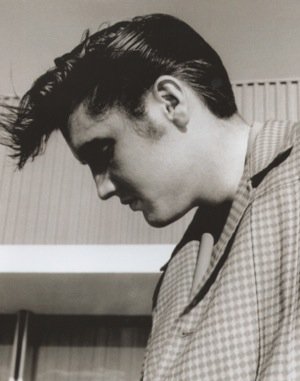
By the time Elvis got his first national exposure on the Dorsey Brothers' show in early 1956, his sideburns were in full bloom. They, combined with the swirled-back long hair on the top of his head, later gave birth to the “Elvis Presley haircut.” As his popularity exploded on the cultural landscape in 1956, many critics and some fellow entertainers (Bing Crosby, among them) strongly suggested that Elvis lose the sideburns. “I like ’em and I’m going to keep ’em,” he declared, and he did all the way through 1957.
In those first two big years of Elvis’ career, critics and columnists couldn’t resist focusing on his sideburns. Hollywood gossip columnist Dorothy Kilgallen referred to Elvis as “Mr. Sideburns.” A December 1956 editorial in the Jackson Clarion-Ledger noted, “The Presley haircut has entered the public domain. And once you let a thing like that loose in the public domain, it just cannot be ignored by any commentator with an ounce of integrity.” In April 1957, when an interviewer told actress Carolyn Jones that, “the morals in Hollywood are as out of date as sideburns,” she countered, “Sideburns are coming back in style, or haven’t you heard of Elvis Presley.” (Miss Jones, of course, starred with Elvis in King Creole a year later.)
• Elvis sideburns panned in print
Published letters to newspapers and columnists routinely condemned Presley’s hair. One sent to columnist Betty Jaycox in April 1957 packaged Elvis’ sideburns with a collection of other alleged physical evils associated with Elvis.
“The other evening I saw a television show featuring a lot of boys and girls in the 17-18 age bracket. All the boys were wearing tight pants, sloppy shirts, long sideburns, and their heads looked like they’d been shampooed by an over-running oil well. To me the whole act was like something which’d crawled from under a rock. But there they were—all having one heck of a time. Maybe cleanliness and neatness are passé, hence the big yen for the hillbilly with the geetar.”
Writer Gordon Gammack took the same tactic in his Des Moines Tribune column in October 1957. “Three slovenly teenagers strolled along Seventh Street the other day,” he observed. “They wore dirty blue shirts. Their hair was greasy and they had Elvis Presley sideburns.”
It wasn’t just the critics and public pundits who were disturbed by Presley’s sideburns. Government institutions, including schools, courts, and law enforcement agencies brought the hammer down on teenage boys who sported “Elvis Presley haircuts.” Journalists, columnists, and private citizens were certainly protected by the First Amendment in their criticism of Elvis’ hair and its perceived negative influence on young people, but when government officials wielded their power against teenagers because of their hairstyles in the 1950s, it was the heavy hand of societal pressure to conform coming down on the right of young people to express themselves.
• Some schools demanded “conventional” haircuts
The most publicized case in 1956 was that of sixteen-year-old Robert Phernetton, a student at Romeo High School in Michigan. That fall, the school’s principal ordered over 50 boys with Elvis Presley haircuts to get “conventional” haircuts or face suspension. Robert was the only one who defied the order, and he was duly suspended from attending school. Supported by his parents, Robert challenged the suspension before the school board and then in the courts. (To read the full story of Robert’s battle to keep his Presley-style sideburns, click on the link at the bottom of this page.)
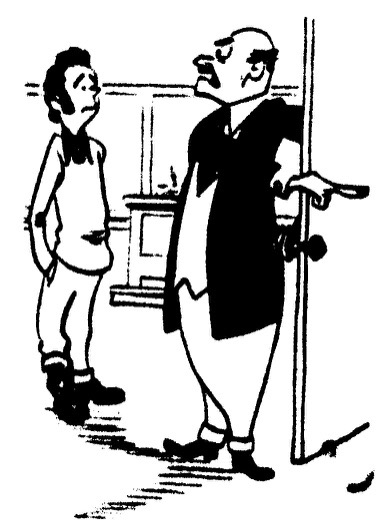
Romeo was not the only high school in 1956-57 to ban students with Elvis Presley sideburns from its classrooms. The school board in Mansfield, Texas, not only banned “Presley-type haircuts” from the community’s high school, but also prohibited students from wearing any clothing referring to him or jewelry “suggesting a Presley influence.” Two girls were sent home in January 1957 for wearing skirts on which the singer’s name was printed.
At Port Huron High School in Michigan, the students themselves organized a Presley-based ban on their fellow classmates. United Press reported that the school’s Student Council ”launched a drive against Elvis Presley haircuts, tight blue jeans, books and leather jackets.” The Council members declared, “Dressing crazy is kid stuff.” (This episode is a reminder that not all teenagers in the fifties were Elvis fans. In fact, there were at least as many teens who disliked Presley as those who championed him.)
• Newspapers divided on student haircut rights
The nation’s newspaper editorial boards were divided on the right of schools to bar sideburns and all things Presley. During the Romeo High School dispute in Michigan, an editorial in the Tampa Tribune read as follows:
“Some doubtless will denounce this principal as an old fuddy-duddy who tramples on the 14thAmendment with his high-button shoes. But we hail him as a Horatius holding a small bridge against the barbarians. There’s a good, old-fashioned firmness to the Romeo principal’s touch which we hope will inspire other school authorities to lay down the law. Like this: ‘Shave off those sideburns, you guys. And while you’re about it, get a pair of pants that don’t look like ballet tights … Class dismissed until compliance.’”
Editorials in other newspapers, like The Indianapolis Star below, defended the tonsorial rights of high school students against the tyranny of school boards.
“As we may have indicated, you couldn’t get a much lower opinion than ours of the Presley sideburns if you went looking for it in a diving bell. For that matter, we never really cared for the way the Hottentots did their hair, either, or the way Yul Brynner doesn’t wear his. But whether it is Presley, Hottentot, Brynner, or a high school sophomore in Romeo, Michigan, we cannot see that any public official in or out of school has any right to tell them how to cut their hair.
“And that goes double for the boys in Romeo high school. They’ve got to go to school because the law says so. The principal says they can’t go to school unless they cut their hair in a way he approves of. For all practical purposes, that means the law says they must cut their hair a certain way. That’s a thing the law wouldn’t dare come right out and say in so many words. What it cannot say, it shouldn’t be made to mean.”
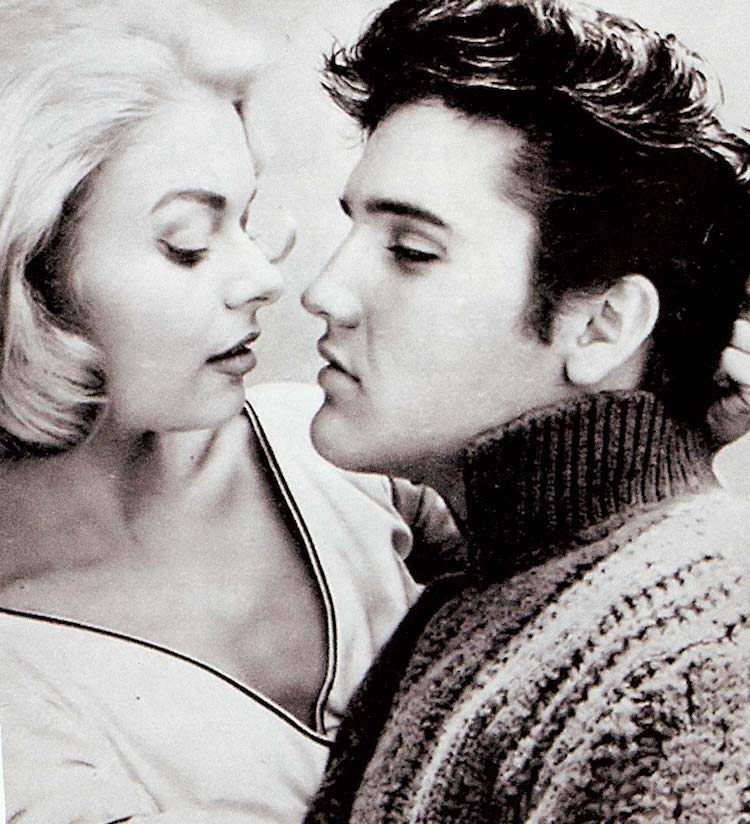
Even at the university level, having Presley sideburns then could cause problems for a young man. Prior to the opening the spring season in 1957, the University of Pennsylvania track and field team coach told sprinter Bruce Dern to either shave off his sideburns to conform with the rest of the team, or else. Dern decided to turn in his tracksuit, explaining that he was interested in pursuing a career in acting, and he felt the sideburns would be an asset in that field. (And, yes, he was the Bruce Dern, who has had a successful acting career through the decades since.)
• Judges brought the gavel down on Elvis sideburns
Unfortunately, as demonstrated in the Phernetton case, the nation’s courts often supported a school’s authority to ban Presley-inspired sideburns. Furthermore, in their courtrooms, some judges weighted their personal disgust for Presley’s hairstyle when dealing with young defendants. During a December 1956 Los Angeles trial for a teenager accused of transporting marijuana, Superior Judge Burnett Wolfson lost his temper. He berated “these punks with these Elvis Presley haircuts which make them look like sheepdogs. It is rather a strange situation that in all of these cases every one has one of these haircuts. I hope the courts can find a right some day to shave their heads.”
Other judges weren’t waiting for “some day.” They were using their power to force young defendants to get rid of their Presley haircuts. One was Magistrate W.A. Stewart in Denton, Maryland. After sentencing, he ordered a 19-year-old defendant, accused of stealing a wallet, to get his Presley-style locks removed in favor of a more conventional haircut. Deputy Sheriff Phonie Andrew escorted the young man directly to a nearby barbershop and supervised the operation. In July 1957, the Associated Press reported that William Sira, 21, sporting an “Elvis Presley haircut—complete with sideburns that almost reached his chin,” appeared before Hudson County, New Jersey, Judge John B. Graf on a charge of violating probation. “Get those ladders off your face, and get a haircut,” Graf told Sira. When he left the courthouse, the AP report noted that Sira had a “cooler head” than when he went in.
Law enforcement agencies also sometimes took matters in their hands when it came to Elvis hairstyles. In October 1957, Indianapolis Sheriff Robert O’Neal announced Presley-type haircuts wouldn’t be tolerated in Marion County Jail. “They are a menace to health in the jail. Those long sideburns will feel the snip of the clippers,” he declared. Ten days later, sheriff deputies, turned barber, had shorn the heads of 103 jail inmates.
In Indianapolis the term “Elvis Presley haircut” had become part of police radio vocabulary. A state police radio call was overheard in City Hall describing a wanted person. The dispatcher gave the details concerning probable age, height, weight and clothing, and then added, “has Elvis Presley haircut.” Local police explained that describing a haircut as an “Elvis Presley” one “saved words and clearly described the person’s hair.”
• A Sideburn gauge and a cat with sideburns
On the lighter side, Elvis and his famous sideburns brought out more than a few entrepreneurs intent on making a buck off his notoriety in the fifties. One was Jacob Cohen, a Chicago laundry owner. In 1957, he invented and patented a gauge to precisely measure the length of sideburns. The gauge fit over the top of the head like a telephone operator’s headset. Where the earphones would be, identical guides on each side moved up and down along graduated scales. To make sure the side-whiskers would be even, the gauge employed a bubble in a glass tube, using the same principle as a carpenter’s level. If, say, a young man wanted his sideburns to end exactly where Presley’s did, he would have his barber set the metal tabs on the desired length on the scale and cut the sideburns off at that level. Of course, a guy could have just trusted his barber to eyeball the evenness of the sideburns and saved himself the cost of the gauge.
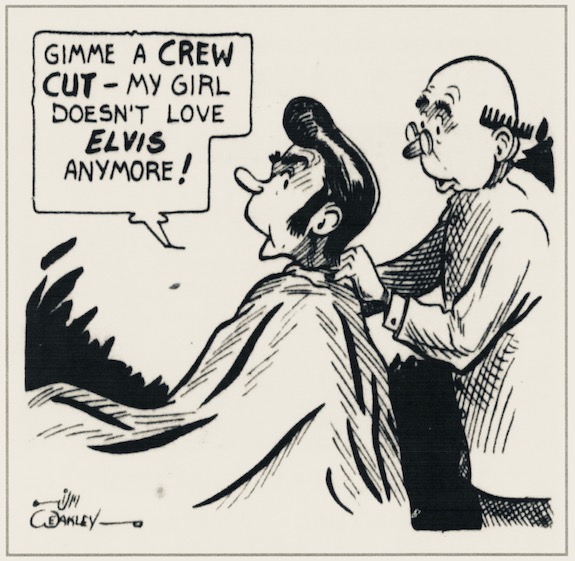
Another offshoot story relating to Elvis’ sideburns started with a telephone call in August 1957 to The Home News in New Brunswick, New Jersey. Nine-year old Doris Schwartz called to say that her kitty, Tabby, had sideburns just like Elvis, and she wondered if anyone else had a cat like hers. Suddenly realizing her daughter was talking to The Home News, Doris’s mother picked up the phone to explain. Mrs. Schwartz verified that, “Tabby has an all black body with a white face, and the black sideburns do somewhat resemble Elvis Presley.”
• Sideburned men faced dangers of mistaken identity
Teenage boys were not the only demographic group growing sideburns in the mid-fifties. Though to a lesser degree, Elvis Presley’s hairstyle also made some inroads with men in their 20s and 30s. On occasion, some of these “older” men found themselves victims of mistaken identity. For example, in May 1957, when a screaming mob of 300 teenagers mistook him for Elvis, Charles King, sporting curly hair and sideburns, had his clothes torn before taking refuge in a Cleveland phone booth.
Multiple cases of Presley mistaken identity occurred at radio station WSM’s Fifth Annual Disc Jockey festival in Nashville on November 9, 1956. A rumor that Elvis was in attendance brought a horde of excited teenagers to the festival venue in search of their idol. Several shouts of “There he is!” resulted in the besieging of disc jockeys, whose only resemblance to Elvis was their long sideburns. Police had to rescue Texas DJ Andy Starr, as fans ripped pockets and buttons off his coat and stripped away his red shoelaces. Armed Forces Radio DJ Kenny Wilder, 24, took advantage of the crowd that descended upon him by passing out 500 pictures of himself. “I don’t know how it happened to me,” he said, “but I thought I’d get in my licks while I could.”
Since most Elvis devotees in the fifties were female, it wasn’t long before someone came up with a “Presley cut” for women. Grand Rapids, Michigan, hair stylist Glenwood F. Dodgson may have been the first to do so. He explained how he developed a Presley style for women to a United Press reporter in February 1957.
“The ‘Presley cut’ began when one of our customers asked for something new and different, something with zip. We pulled a couple of whisps of hair down in front for the bangs effect. Then we put on sideburns to soften her features and a few pin curls to blend the back of the hair with her neckline (“ducktail” fashion). We kidded her and told her it was an Elvis Presley hair style.”
A hair stylist for 20 years and owner of 10 salons, Dodgson said the new haircut would give women a “natural and casual look, but still have that reckless touch. It’s ideal for spring and summer. It is mainly for teen-agers, but it would look well on older women with the right features.” Dodgson estimated that between 300 and 400 women had come into his salons asking for “Presley cuts” since he gave the first one in January 1957. “It’ll sweep the nation,” he predicted.
• The fascination with Elvis’ sideburns continued
And what about the set of sideburns that started all that public ruckus, those that bookended Elvis Presley head? They continued to be on display wherever he appeared in 1956 and 1957—at over 120 concert dates, during 12 national network TV appearances, and in three Hollywood movies. All the while, the debate raged on. The critics wanted the sideburns gone; the fans wanted them to stay.
In the summer of 1957, Helen Magyar and Alice Steinhauer, both 19, from St. Paul, Minnesota, unexpectedly had a up close encounter with the famous sideburns. After graduating from high school the year before, they worked for a year to earn enough to pay for a trip to Memphis. At 8 p.m. one evening, they showed up at the gates of Graceland. After convincing gate tender Uncle Travis Smith to send a note up to Elvis, the girls we told he would see them. He greeted the nervous girls halfway up the winding drive to Graceland. They gave Elvis a teddy bear they had bought for him, and he, in return, planted a kiss on each girl’s cheek. During their conversation with Elvis, they asked if they could do something they’d wanted to do for a long time. “He let us run our fingers through his sideburns,” they later told the Memphis Press-Scimitar.
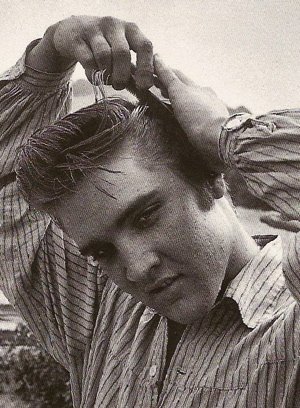
While Elvis’ sideburns fascinated his multitude of young female fans, his critics longed for the day they would disappear. Since Elvis apparently wasn’t going to get rid of them himself, his detractors looked around for someone else who could do the job. The most promising candidate was an Army barber. The Memphis Draft Board had added Elvis to the bottom of its draft pool list following his 18thbirthday in 1953. When he would be called up, if ever, depended on the board’s draft quota. For Presley’s critics, the sooner his number came up, the better. A Billboard article in October 1956 expressed some wishful thinking. “The most famous sideburns in America will be shaved early in December,” the writer avowed, “when Elvis Presley reports to Fort Dix, NJ, as an army inductee.” Actually, Elvis didn’t undergo his pre-induction physical until January 4, 1957. He passed, and four days later, on his 22ndbirthday, Elvis Presley was classified as 1-A, meaning he could be drafted at any time.
The euphoria of Presley’s enemies in the press was soon deflated, however, when an army spokesman predicted that Elvis would go into the special services branch and be allowed to keep his long hair. The editorial board of The Tampa Tribune was especially disappointed by the news. “It had been idyllic to contemplate Elvis in the GI barber’s chair, amid the fallen sideburns and the ravished ducktail,” the paper sadly noted.
• Elvis expected Army to shave his sideburns
But suddenly the hopes of Presley’s detractors were revived. Higher ups in the Army decided Elvis would indeed have his sideburns shaved off after he was drafted. To the surprise of his critics, Elvis agreed. “There never has been anyone who could avoid having his hair cut short in the Army,” he reasoned. “Even if they did give me special permission, I wouldn’t want it.” In March 1957, Elvis repeated his willingness get an Army haircut to Hollywood columnist Vernon Scott.
“The sleepy-eyed king of the rock ’n’ roll set brushed a straggle of hair from his forehead and said, “Ah’m not worried about my hair or sideburns. Seems like lots of others are concerned with my going into the Army, though. Everybody who goes into the service gets their hair cut. Ah expect it—and ah wouldn’t have it any other way.”
The critics couldn’t wait—but suddenly it appeared as if they wouldn’t have to. Elvis, himself, brought up the prospect of getting a pre-army head shave. During a press conference prior to a stage show in Chicago on March 29, 1957, Elvis revealed that, if the Army didn’t get him first, he would exchange his lavish sideburns and duck-tailed hairdo for a crew cut for his next movie. In Jailhouse Rock, which would begin production five weeks later in May, Presley would play a penitentiary prisoner. So it appeared that an MGM barber instead of an Army one who would remove the famous sideburns. The Arizona Republic reported that Elvis would actually be de-haired during a scene in the movie.
“Elvis Presley’s movie studio issued a communiqué yesterday that it has picked a filmland barber to brave the wrath of teenage disciples by shearing the side-burned rock ’n’ roller in a movie. Metro-Goldwyn-Mayer Producer Pandro S. Berman tapped Joseph Bullaro for the job, largely on the basis of experience. Bullaro has trimmed such celebrities as Bing Crosby—just a little on the sides—and Clark Cable. He will give undulating Elvis the full business—a ‘butch’ haircut—in Presley’s forthcoming picture ‘Jailhouse Rock.’ Bullaro will play a prison barber, and Elvis a prisoner.
However, four thousand letters and cards from Presley fans begging MGM to let their hero keep his sideburns and signature hairdo forced the studio to come up with a new strategy. “So now the studio has decided I’ll wear a wig, a crew-cut wig, for the prison scenes,” Elvis explained to columnist Aline Mosby. A news service article described two versions of the star as he appeared on the Jailhouse Rock set: “Elvis got his hair ‘cut’ every morning at 7:30 a.m. At 6:00 p.m. every evening, it mysteriously grew back and Elvis could walk out of the studio looking like—Elvis Presley. On the screen, of course, he appears in several sequences … without his long mop of wavy hair flapping in his eyes, and for the first time without his characteristic sideburns.”
So, it seemed it was going to be an Army barber after all who would shear off Elvis Presley’s sideburns. Elvis received his draft notice on December 19, 1957, and, after a 60-day deferment granted for him to complete his work on King Creole, his induction was set for March 24, 1958. Press photographers left open their calendars for that week to record the long-awaited shaving off of Elvis Presley’s sideburns.
It turned out, though, that Elvis’ sideburns were gone before he entered the army, and there were no photographers on hand to record the event. Sometime before principal photography for King Creole began in the New Orleans French Quarter on March 3, 1958, Elvis decided to have his sideburns removed. “I’ve worn long sideburns in all my other movies,” he told Hollywood writer James Bacon, “so I figured I’d be a little different in ‘King Creole.’” So what happened to the famous side-whiskers that had caused so much angst and adoration during the first two momentous years of Elvis Presley’s career? Most likely, they were swept up off the floor and dumped into the trash bin of history. — Alan Hanson | © March 2019
Read about Robert Phernetton’s case in Romeo, Michigan
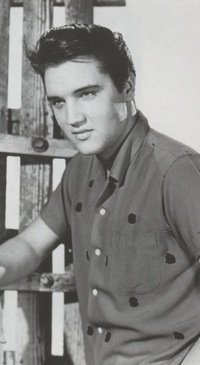
“The Presley haircut has entered the public domain. And once you let a thing like that loose in the public domain, it just cannot be ignored by any commentator with an ounce of integrity.”
